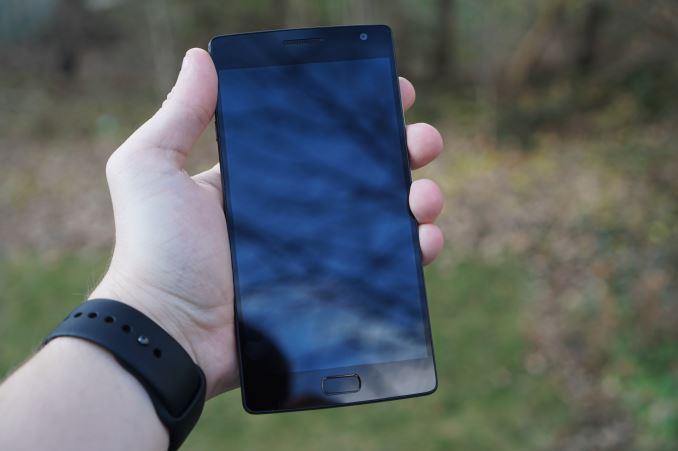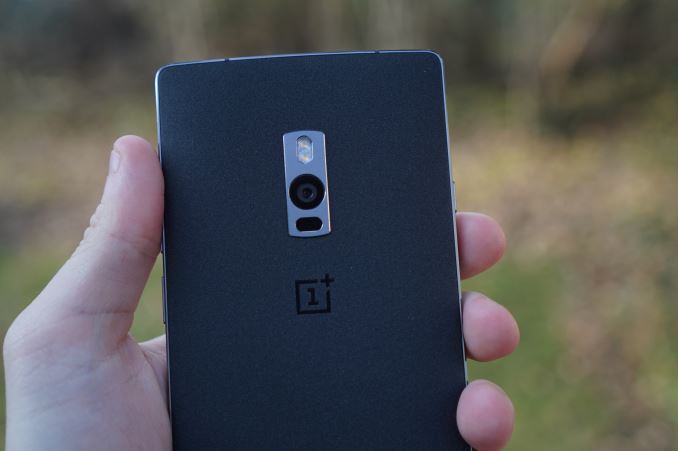The OnePlus 2 Review
by Brandon Chester on December 14, 2015 8:00 AM EST- Posted in
- Smartphones
- Mobile
- OnePlus
- OnePlus 2
Final Words
After using the OnePlus 2 for quite some time and going over the results of my testing, I can't say I'm thrilled with how things turned out for OnePlus's second smartphone. There are a lot of really odd regressions from the original, and when that's accompanied by an increase in price it makes me wonder why someone wouldn't seek out a OnePlus One, or a smartphone from a different vendor entirely. There were definitely some improvements over the OnePlus One as well, some of which are due to the changes in software that have been made since that time. Before making any conclusions, I'd like to go over the major aspects of the OnePlus 2 and see how they hold up to both the OnePlus One, and the rest of the competition in the increasingly competitive smartphone space.
Unfortunately, the OnePlus 2's display was one of the first things I realized represented a regression from the OnePlus One. Right when I started using the phone it was clear that the color rendition was not in line with what I have seen on recent smartphones. Measurements of the display confirmed that it's far too blue, and not accurate beyond matching the primary colors of the sRGB gamut. The substantial changes to the display characteristics that often come with OTA updates never actually improve the display in any meaningful way, and the fact that the accuracy is such an enormous regression from the OnePlus One is just completely unacceptable.
Performance is another area where the OnePlus 2 is extremely disappointing. Snapdragon 810's issues are well documented at this point, but the OnePlus 2 ends up being the worst implementation that I've seen, with the Cortex A57 cores never being used at all in circumstances like web browsing or when navigating the UI. It makes the phone feel like a Moto E, which is something I remarked on before even realizing exactly what was wrong with the CPU's behavior. When considering the performance of the OnePlus 2, it's more accurate to think of it as buying a quad core Cortex A53 device than a 4x4 Cortex A57 + Cortex A53 device.
Thankfully, it's not all bad news. While the performance is certainly not what you'd expect from the advertised specs, the phone gets pretty great battery life as a result. The construction of the phone is also quite good, with very few visible seams due to the type of back cover attachment method OnePlus has used. I'm still not a fan of the back cover material, but I recognize that as a very subjective feeling and so I wouldn't consider that as an aspect that is necessarily positive or negative. As for the camera, OnePlus has put some significant effort into improving their image processing, and there's no longer any issue with chroma noise across the frame even in broad daylight. I think OnePlus still has room to improve in this regard, particularly where noise reduction is concerned, but in its current state the OnePlus 2 produces fairly good photos considering its price tag.
Unfortunately, even with a decent camera, good battery life, and a nice chassis, the OnePlus 2 simply has too many flaws that can't be overlooked. Like the original, the OnePlus 2's tagline is "Never Settle". Unfortunately, the OnePlus 2 does make you settle in many ways. You have to settle for not having Quick Charge 2.0 support, and you have to settle for not having NFC which locks you out of Android Pay. You have to settle for a very poorly calibrated display which pales in comparison to the original. Most disappointing of all is that you have to settle for poor performance, when moving through the UI, browsing the web, and doing anything remotely CPU intensive. You have to settle for a great number of concessions, many of which didn't exist on the OnePlus One, and none of which should exist at this price point.
At $389, you can find much better smartphones, such as the Nexus 5X, or you can search for sales on phones like the Galaxy S6 or LG G4 if you're in a region where the Nexus phones end up being much more expensive than Google's price in North America. Even the OnePlus One would offer a better overall experience. Regardless of what your needs are when buying a smartphone, I think there will be better options available to you than the OnePlus 2.












132 Comments
View All Comments
LiverpoolFC5903 - Tuesday, December 15, 2015 - link
Sorry for sounding thick! So basically even though ALL the cores are operating synchronously, indvidual cores in a cluster can be into different power states and/or shut off altogether?How does this compare with something like a Snapdragon 801 where all 4 cores run at different frequencies depending on the workload?
phoenix_rizzen - Tuesday, December 15, 2015 - link
The cores in the S810 work the same way as in the S801.There's 3 ways that ARM's big.LITTLE setup works:
1. Cluster migration: either the A57 cluster is active, or the A53 cluster is active. The OS only ever sees 1 cluster of cores (so an S810 would appear as a 4-core SoC). This is done in hardware on the SoC itself.
2. Core migration: each A57 core is paired with an A53 core. Either the A57 or the A53 is active in each pair, never both at the same time. But an A57 from pair 1 can be active while an A53 from pair 2 is active, while the other two pairs are offline, for example. The OS only ever sees 1 cluster's worth of CPUs (so the S810 would appear as a quad-core). I believe this is done in hardware on the SoC itself.
3. Forget the name of this one, but all cores in all clusters are available for scheduling, and it's up to the OS to manage everything. 1 core can be online, 2 cores can be online, all the way up to all 8 cores can be online. And the kernel scheduler determines whether a process runs on an A53 core or an A57 core.
The first big.LITTLE SoCs from Samsung (the Exynos 54xx-something) used method 1. The latest big.LITTLE SoCs from everyone (Exynos 7xxx, Snapdragon 810/808, MediaTek Helios, etc) uses method 3.
LiverpoolFC5903 - Wednesday, December 16, 2015 - link
Thanks mate, but as Andrei pointed out, my question was a different one. But useful information all the same.Andrei Frumusanu - Tuesday, December 15, 2015 - link
Please ignore phoenix's comment, he seems to have misunderstood the question at hand.The Snapdragon 801 behaves as you say, they each have individual frequencies, meaning they're all on their own clock domain. Also each core has their own power domain, meaning each core can be individually turned off.
The difference again is that ARM CPUs such as the A57 in the S810 have all the same clock domain. However even if they all have the same clock they can still be individually powered off as the power domains are individual as well.
As to how it compares, it has both benefits and disadvantages. But there seems to be no clear winner.
LiverpoolFC5903 - Wednesday, December 16, 2015 - link
Thank you Andrei, its pretty clear to me now! Synchronous cores (A57, standard ARM cores) have the same clock domain which means cluster frequency remains the same. However, individual cores within each cluster can be powered off based on need and workloads.And Krait based quadcores have different clock domains for each core as well as different power domains.
Understood.
WoodyPWX - Tuesday, December 15, 2015 - link
Nice and honest review as always, thank you! A Lumia 950xl review would be awesome.victorson - Tuesday, December 15, 2015 - link
I love Anand and the insight in the reviews, but sometimes you guys throw something that even the more experienced reader will find hard to understand. "As always, all devices are calibrated to 200nits except when their brightness curves necessitate testing above that value." Could you kindly elaborate on what is that supposed to mean to those of us who are interested in display quality, but don't have a PhD on the matter? :)Ryan Smith - Tuesday, December 15, 2015 - link
As close to 200nits as we can get. If we can't hit 200 exactly, then it's the first value over that which we can hit.kasakka - Tuesday, December 15, 2015 - link
The sandstone black back cover is one of the best things about Oneplus phones. It really helps keeping a big phone like that firmly in your hands. By comparison the Oneplus X or iPhone 6S really needs a cover because they are very slippery.Where Oneplus went wrong with the Two was the Snapdragon 810 and that it's not that much of an upgrade from the One. As a One owner, the only things I'd like from it are LTE band 20, better speaker and vibration motor and the fingerprint reader which is positioned very poorly. On phones this size they should be in the back like on the Nexus phones because reaching down to that bottom area when using with one hand is quite annoying. I use the onscreen buttons on my One because of the same reason.
I really hope they manage a better design with the inevitable Oneplus Three. I like that they haven't jumped on the 1440p bandwagon because that doesn't really give any benefit in phones at this screen size. Just more pixels to push.
lid - Tuesday, December 15, 2015 - link
Thank you for providing LTE band information! It has always been a deciding factor for me, since I travel constantly. This phone doesn't seem great for anyone who frequently visits the EU from the US (since the US version is missing LTE band 3), or vice versa (since the EU version is missing LTE bands 2/4).